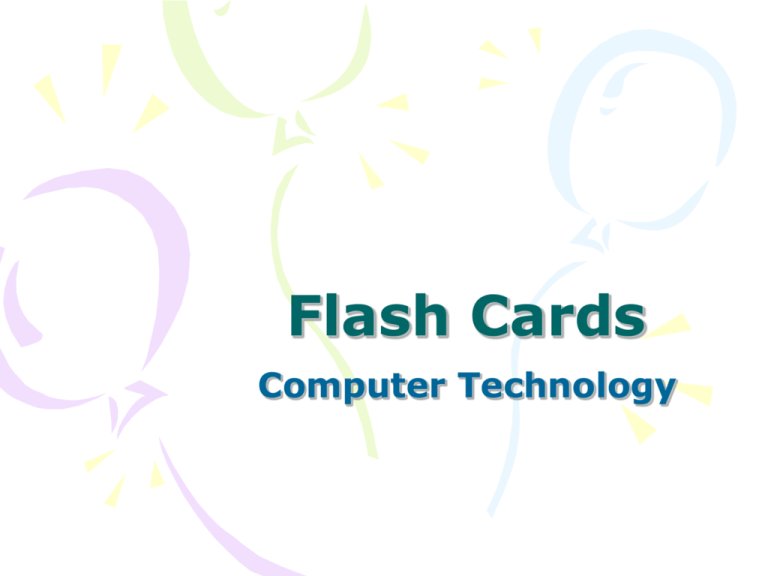Flash Cards (Terms)
advertisement

Flash Cards Computer Technology Flash Cards #1 A device that accepts input, processes data, stores data, and produces output. Data Hardware Computer Storage Network Collection of unprocessed items, which can include text, numbers, images, audio and video. Physical components of a computer that you can touch including the processor and peripheral devices. Two or more computers and other devices that are connected, for the purpose of sharing data and programs. Area of the computer that holds data, instructions, and information for future use. Flash Cards #2 External components connected to the computer, but not inside the system unit. The primary input device to the computer. When a user enters data into a computer. Case that holds the power supply, storage devices, and the circuit boards. Area of the computer that temporarily holds data waiting to be processed, stored, or output. Flash Cards #3 Manipulation of the data in many ways. RAM Information Processing Software Storage Devices The results of processed data. It conveys meaning and is useful to one or more people. Used to keep data when the power to the computer is turned off. The main memory of the computer. Information stored here is lost when the power to the computer is turned off. A computer program that tells the computer how to perform particular tasks. Flash Cards #4 Approximately 1,000 bytes. Bit Boot Process Kilobyte Sequence of events that occurs between the time you turn on a computer and the time that it becomes ready to accept commands. Approximately 1 billion bytes Gigabyte Each 0 or 1. ROM Drives can read data from disks, but cannot store new data on them. Flash Cards #5 Approximately 1 trillion bytes. Binary Code The language of a computer--it consists of only two digits, 0 and 1. Byte Megabyte A measurement used to describe the speed of the processor. Megahertz Approximately 1 million bytes. Terabyte 8 bits. Flash Cards #6 CPU Where the processing in a computer takes place, often called the brain of the computer. Input Devices One of the most important innovations of mankind. It paved the way for modern PCs. Also called microchip or integrated circuit. Output Devices Units that gather information and transform that information into a series of electronic signals for the computer. Silicon Chip Devices that display, print, or transmit the results of processing from the computer’s memory. Work Station Powerful desktop computer designed for specialized tasks. Flash Cards #7 Large expensive computer capable of processing data for hundreds or thousands of users. Mainframe Laptop Computer Display device that show an image on a computer screen. Microcomputer Output device that produces text or graphical images on paper. Monitor A portable, compact computer that can run on an electrical wall outlet or a battery unit. Printer A personal computer; designed to meet the computer needs of an individual. Flash Cards #8 Desktop Computer Microcomputer that fits on a desk and runs on power from a wall outlet Handheld Software required for the computer to run: Windows, Mac OS, Linux Operating System A computer that was the fastest in the world at the time it was constructed. Server Supercomputer A computer that supplies its users with data; usually through the use of a LAN (local area network). A computer that fits into a pocket, runs on batteries, and is used while holding the unit in your hand. Flash Cards #9 Usually mounted inside the computer’s system unit and can store billions of characters of data. CD-Rom Folders Hard Disk Underlying hardware and software of the computer system. The subdirectory or subdivision, of a directory that can contain files or other folders. Platform Resolution The density of the grid used to display or print text and graphics. Storage device that uses laser technology to read data that is permanently stored on compact disks, cannot be used to write data to a disk. Flash Cards #10 A unique identifying number assigned to each computer connected to the internet. GUI LAN Virus IP Address A user interface that features on-screen objects, such as menus and icons, manipulated by a mouse. Interconnected group of computers and peripherals that cover a large geographical area, such as multiple buildings A program intentionally designed to cause annoyance or damage to computer hardware or software. WAN Computer network that is located within a limited geographical area, such as a school or small business. Flash Cards #11 Application Software Recording on a CD or DVD with the use of a low-power laser light. Floppy disk Software designed to that help a person carry out a specific task. Magnetic Storage Running more than one program at a time. Multitasking Optical Storage Portable magnetic storage medium usually read in the A: drive Type of storage media that uses magnetic particles to store items on a disk’s surface Flash Cards #12 Ethics Copyright E-mail Acceptable Use Policy Software License Used to protect a network and the users on that network and provide guidelines to how a network can and should be used A form of legal protection that grants certain exclusive rights to the author of a program A legal contract that defines the ways in which you may use a computer program The rules or standards governing the conduct of a person or the members of a profession Sending an electronic message to another person or to a group of people




